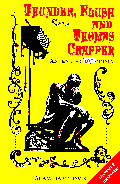Thunder, Flush and Thomas Crapper: R
^UP^ to Thunder, Flush and Thomas Crapper index.
Chapters: A B C D E F G H I J K L M N O P R S T U V W Y Z

Extracts from Adam Hart-Davis's book.
(Buy the book from Micheal O'Mara Books, ISBN 1-85479-250-4, hardback 1-85479-245-8, or in the US, ISBN 1570760810.)
- RAF Aircrew
-
 In the early days, RAF aircrew were supplied with chemical
lavatories, so when the Dambusters went, they went on Elsans. Modern
versions are still used in Hercules transport aircraft.
In the early days, RAF aircrew were supplied with chemical
lavatories, so when the Dambusters went, they went on Elsans. Modern
versions are still used in Hercules transport aircraft.
Tornadoes and other fast jets don't have time or space for the pilots and other aircrew to use conventional lavatories; so they pee into a disposable 'piddle-pack'. This is a plastic bag like a colostomy bag, strapped to the leg inside the flying suit, which is rubberized like a wet-suit. The bag has a plastic valve, and a sponge inside to prevent the urine from sloshing about.
Both the RAF and the USAF are having to think fast about providing for the female pilots coming into service.
See also aircraft.
-
In Nelson's navy the 'heads' for the lower
ranks were simply holes in a wooden plank or planks
projecting in front of the bows beside the figurehead; often,
on small ships, dangerously close to the waterline. The
excrement fell straight into the sea, and was carried away by
the bow wave.
If the users were unlucky and the waves were rough, a good deal of the sea came up through the holes. On ships as big as the Victory the heads were safer because they were high above the waterline.
The lavatories were called 'heads' because the whole of the front of the ship is called the head. A rival theory that the sitter shouted 'heads' to warn anyone below not to stick their head out of a porthole seems highly unlikely; there are never portholes in the extreme bows.
- Modern navy loos
-
All modern navy ships rely on 'collect,
hold, and transfer', using either a vacuum system, or a
biological system. The vacuum systems are the same as on
commercial ships; they use a small (1.2 litre) fresh-water flush,
mainly to refill the bowl. The effluent is removed by the
vacuum from below and transferred to the holding tanks---usually
two or three per ship.
Text extracts from "Thunder, Flush and Thomas Crapper" copyright (c) Adam Hart-Davis 1997. Web extracts first published 2007-07-18, updated ✎2018-02-25
Images available from the DHD Multimedia Gallery.
Site content copyright (c) Damon Hart-Davis 1997--2018 unless otherwise stated.
Hosted by ExNet.